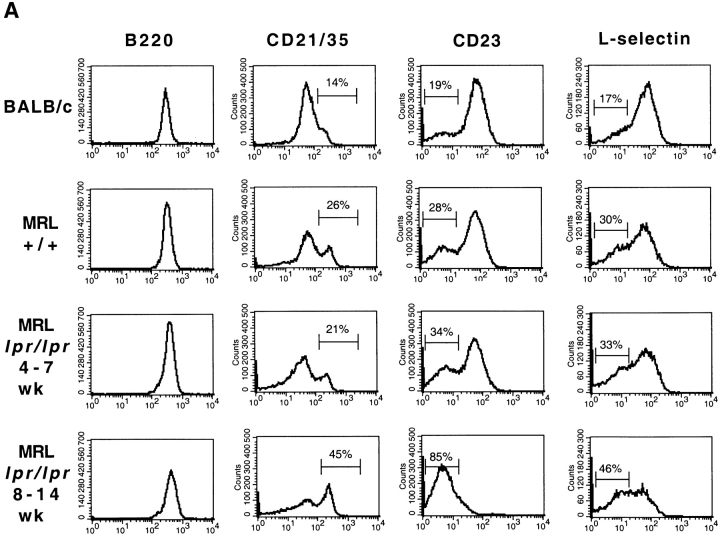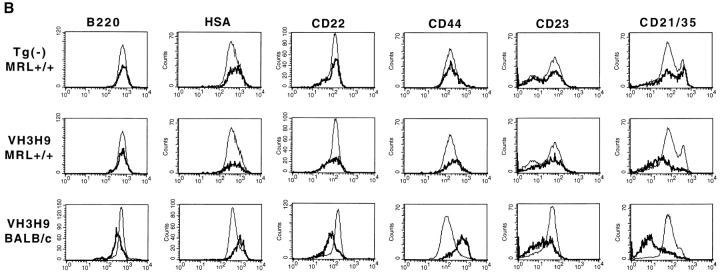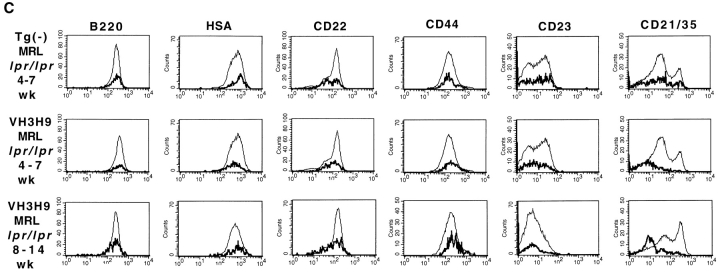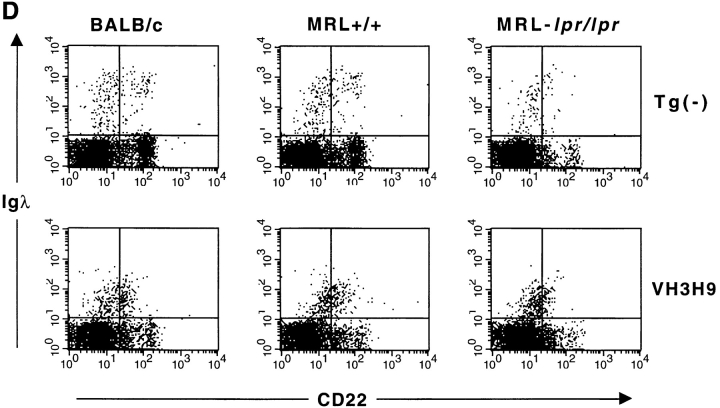Figure 3.
Phenotypic analysis of Tg− and VH3H9 (A–C) splenic and (D) BM B cells in age-matched BALB/c, MRL+/+, and MRL-lpr/lpr mice. (A) Tg− mice. Histograms show staining of total B cell population (gated on B220+Ig+ cells). Percentages are given for the indicated gates on representative plots. There is an exaggerated population of CD21high cells (MFI > 200) present in MRL+/+ (32.9 ± 11.5%) and MRL- lpr/lpr (40.1 ± 9.9%) compared with BALB/c (7.9 ± 3.1%) mice (P < 0.0001). CD23 levels decrease on MRL-lpr/lpr B cells as the mice age (percentage of CD23low B cells at 4–7 wk, 48 ± 10.6% vs. at 8–14 wk, 70.4 ± 8.7%; P = 0.03). There is also an increased population of CD23low B cells in MRL+/+ mice (MRL+/+, 48 ± 11.3% vs. BALB/c, 16.4 ± 3.4%; P = 0.016), although not to the extent in 8–14 wk MRL- lpr/lpr mice (70.4 ± 8.7%; P = 0.0003). The proportion of L-selectinlow B cells is increased in MRL-lpr/lpr (38.8 ± 13.6%) and MRL+/+ (38.4 ± 13.9%) compared with BALB/c (23.5 ± 4.8%) mice (P = 0.009). VH3H9/λ B cells in (B) MRL+/+, BALB/c, and (C) MRL-lpr/lpr spleen. Histograms are gated on the total B cell population (thin line) and Igλ+ population (bold line). The underlaid histograms (thin line) were scaled down to allow for comparison to the λ+ B cells (which comprise ∼10% of the total B cell population). The majority of markers show that VH3H9/λ B cells in MRL+/+ and MRL-lpr/lpr mice, unlike in BALB/c mice, are no longer developmentally arrested; however, CD21/35 levels are decreased. VH3H9 BALB/c, VH3H9 MRL+/+, and VH3H9 MRL-lpr/lpr mice at 4–7 wk are λ ANA−, whereas VH3H9 MRL-lpr/lpr mice at 8–14 wk are λ ANA+. VH3H9/λ B cells in MRL-lpr/lpr and MRL+/+ spleens are developmentally mature regardless of the mouse's ANA status. (D) BM B cells were stained with CD22 and Igλ. VH3H9/λ B cells are Iglow at the CD22low stage (VH3H9/ Igλ MFI, 50 vs. Tg− Igλ MFI, 200) and do not decrease as the B cells mature (VH3H9/Igλ MFI, 68 vs. Tg− Igλ MFI, 480), suggesting an encounter with Ag at an early developmental stage. Note that there is a decrease in the CD22high population (23 to 6%) in MRL-lpr/lpr mice, with and without the VH3H9 Tg. This is consistent with a previous report that documents a decrease in the frequency of mature B cells in the BM of MRL-lpr/lpr mice (reference 87). All graphs are plotted on a log scale. n = 7 mice at each age range for each genotype.




